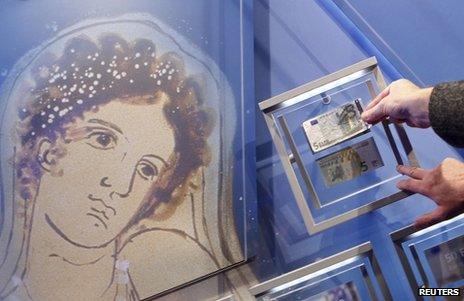Greek goddess Europa adorns new five-euro note
- Published

In ancient times Europa's name referred to Thrace - a region in the Balkans
The ancient Greek goddess Europa features on a new five-euro note unveiled by the European Central Bank.
It appears as both a watermark and hologram on the note, which otherwise largely resembles its predecessor.
Other notes will likewise be reissued in what is only the second series of euro banknotes since the single currency's launch on 1 January 1999.
The new series, external will be phased in over several years with the five-euro note entering circulation in May.
Europa has featured on some euro coins before.
The new notes are appearing at a time of continued uncertainty about the 17-nation eurozone's stability. Last year there was intense speculation that struggling Greece might have to exit the eurozone, so some may see it as ironic that a Greek goddess is now the face of the euro.
In order to use up remaining stocks in many eurozone countries, the original five-euro notes will be issued for several months alongside the new ones. The two series will circulate in parallel as legal tender.
The ECB has not yet set a termination date for the first series as legal tender, and says the deadline will be announced well in advance.
In Greek mythology, Europa was a noble Phoenician woman whose beauty inspired the god Zeus to seduce her. He appeared to her as a white bull and carried her away to Crete. Later she bore Zeus three sons, one of whom, Minos, became ruler of Crete.
The image used on the five-euro note comes from a vase in the Louvre Museum in Paris. The vase is more than 2,000 years old and was found in southern Italy.